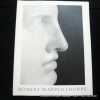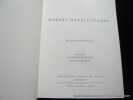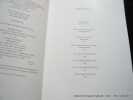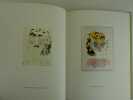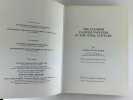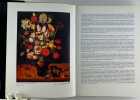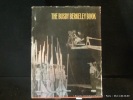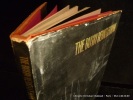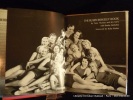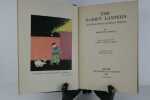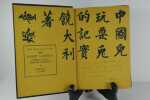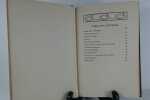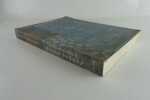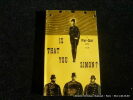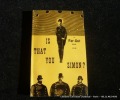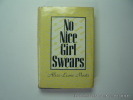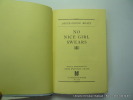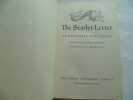292 books for « with e »Edit
-
Type
Book (286)
New book (6)
-
Latest
Last 3 days (15)
Last month (6)
-
Language
Czech (1)
English (13)
French (270)
Japanese (6)
Russian (2)
-
Century
16th (1)
17th (1)
18th (13)
19th (24)
20th (107)
21st (24)
-
Countries
Belgium (87)
Canada (14)
China (9)
Denmark (44)
France (109)
Greece (3)
Switzerland (12)
United Kingdom (13)
United States of America (1)
-
Syndicate
ALAC (14)
CLAM (1)
CLAQ (1)
ILAB (111)
NVVA (4)
SLACES (4)
SLAM (30)
Topics
- American literature (2)
- Archaeology (2)
- Architecture (14)
- Artists (2)
- Belgium (7)
- Berkeley (2)
- Berlin (1)
- Biography (2)
- Buddhism (3)
- Chemistry (6)
- Child care (1)
- Children’s books (2)
- China (3)
- China (4)
- Christie's (2)
- Christmas (1)
- Circus (1)
- Co-operation (8)
- Collaboration (15)
- Cyprus (1)
- Dance & ballet (2)
- Dedication (2)
- Drama (4)
- Drawings (1)
- Early printed books (1)
- Earth (1)
- Egypt (1)
- English (7)
- Essays (10)
- Ethic (1)
- Ethnography (1)
- Fantasy (2)
- Fine arts (1)
- First edition (2)
- Flora (3)
- Flowers (3)
- Gastronomy (1)
- Geology (4)
- Germanic languages (1)
- Greece (1)
- Healthcare (1)
- History (15)
- Hugo victor (2)
- Illustrated books (2)
- Industrial arts & crafts - fine arts (3)
- Inventions (1)
- Iron (6)
- Japan (3)
- Java (3)
- Literature (4)
- Love (2)
- Magazine (10)
- Marie louise (2)
- Marquet albert (1)
- Medicine (4)
- Merlin (1)
- Military arts (2)
- Monaco (1)
- Museums (1)
- Navy (1)
- Occult (1)
- Opera (1)
- Opera ballet (1)
- Orchestra (2)
- Orientalism (1)
- Painting (2)
- Paris (4)
- Photography (8)
- Physics (3)
- Professions guilds (1)
- Railway (16)
- Railway pc (1)
- Religions (2)
- Scandinavian (2)
- Sciences (10)
- Sciences & mineralogy (2)
- Sculpture (4)
- Shelley (1)
- Silversmith’s trade (2)
- Sportsmen (1)
- Swing (1)
- Tales (1)
- Tea (41)
- Technology (5)
- Thales (1)
- Theatre (2)
- Theology (1)
- Turbine (2)
- Turner (2)
- Various (3)
- Volcanos (1)
- Williams tennessee (1)
- Zoology (3)
Richard Marshall. With essays by Richard Howard and Ingrid Sischy (Robert Mapplethorpe)
Reference : 71151
(1990)
Robert Mapplethorpe. Second printing.
New York. Boston. Toronto. London, Whitney Museum of American Art, in association with Bulfinch Press - Little Brown and Company. , 1990, in-4, broché, 216 pages. Marques d'usage sur la couverture. Mouillure en marge des 10 dernières pages, n'affectant pas les photographies.
NB Le délai d'acheminement vers la France est de 48h.
Jim NUTT - Lynne Warren. With essays by Jennifer R. Gross, Alexi Worth
Reference : 82064
(2011)
JIM NUTT Coming into character
Paris, Museum of Contemporary Art in Chicago, 2011, in-4, hardcover, 123p. ISBN: 9780300172386. Very good condition. 70 plates.
NB Le délai d'acheminement vers la France est de 48h.
Marie-Louise HAIRS. With the cooperation of Domimnique FINET. Translated into English by Eva Grzelak
Reference : 84477
(1985)
The flemish flower painters in the XVIIth century
Brussels, Lefebvre & Gillet, Art Editors, 1985, in-4, relié sous jaquette illustrée, 518p. Marques du temps sur la jaquette, sinon très bon état.
NB Le délai d'acheminement vers la France est de 48h.
Tony Thomas and Jim Terry, with Busby Berkeley. Foreword by Ruby Keeler
Reference : 57434
(1973)
The Busby Berkeley Book
Paris, New York Graphic Society Ltd, 1973, in-4, relié-jaquette éditeur, 184 pages. Frottements sur la jaquette sinon bon exemplaire.
NB Le délai d'acheminement vers la France est de 48h.
Dorothy ROWE. With introduction by Lucius Chapin Porter. Illustrations by Ling Jui Tang.
Reference : 83787
(1925)
The Rabbit Lantern
New York, The Macmillan Company, 1925, in-12, cartonnage éditeur, 98p. Ex-dono sur la page de garde. Bon état. Good condition.
NB Le délai d'acheminement vers la France est de 48h.
Jasper Johns. A Retrospective.
New York, The Museum of Modern Art, 1996, in-4, broché, 408p. Bon état. Good condition.
NB Le délai d'acheminement vers la France est de 48h.
A cosmic drama by Akbar del Piombo with collages by Norman Rubington
Reference : 1927
(1961)
Is that you Simon?
Paris, The Citadel Press - The Olympia Press , 1961, in-12, broché, np Bon état.
NB Le délai d'acheminement vers la France est de 48h.
The Hero maker
Paris, A Traveller's Companion, published by The Olympia Press, 1960, in-12, broché, np Couverture légèrement frottée. Un accroc en pied.
NB Le délai d'acheminement vers la France est de 48h.
The Boiler maker
Paris, The citadel Press - The Olympia press / New-York Paris, 1961, in-8, broché, np. Very Good. Bon état.
NB Le délai d'acheminement vers la France est de 48h.
A cosmic drama by Akbar del Piombo with collages by Norman Rubington
Reference : 79208
(1961)
Is that you Simon?
Paris, The Citadel Press - The Olympia Press , 1961, in-12, broché, Bon état.
NB Le délai d'acheminement vers la France est de 48h.
Grand Illusions
New-York, Mac Graw -Hill Book Company., 1973, Broché,
NB Le délai d'acheminement vers la France est de 48h.
Paul Outerbridge. Essay by elaine Dines-Cox with Carol McCusker. A personal portrait by M.F. Agha, edited by Manfred Heiting
Reference : 35675
(1999)
Paul Outerbridge 1896 - 1958
Paris, Taschen, 1999, Relié-Jaquette éditeur, 251 pages. Bon état
NB Le délai d'acheminement vers la France est de 48h.
No nice girls swears. Signed.
New-York, St. Martin's / Marek, 1983, in-12, relié sous jaquette, 185 pages. Signed. Small tears on the dustj. Good.
NB Le délai d'acheminement vers la France est de 48h.
Jon B. J. Jansen and Stefan Weyl. WIth a foreword by Reinhlod Niebuhr
Reference : 73786
(1943)
The Silent War. The underground movement in Germany.
Paris, 1943, in-8, cartonnage éditeur, 356 pages. First edition. Except two little tears on the cover, good condition. Deux accrocs sur la couverture, sinon bon état.
NB Le délai d'acheminement vers la France est de 48h.
Hawtorne Nathaniel. WIth illustrations by Nell Booker. Introduction by Carl van Doren
Reference : 73797
(1946)
The Scarlet Letter.
Cleveland and New York, The World Publishing Company, 1946, in-12, cartonnage éditeur / red hardcover, 254 pages. Bon état. Good condition.
NB Le délai d'acheminement vers la France est de 48h.
VOISENON, Claude-Henri de Fuzée, Abbé de - notice bio-bibliographique par Octave UZANNE ***___***___*** 8vo half-morocco with green corner bronzes, very decorated back with five false-nerves and, top edge guilt, LXVI-222 pages, a portrait engraved by AD LALAUZE according to COCHIN, a label engraved by A. MONGIN, a facsimile, a plate engraved by A. MONGIN according to GRAVELOT, a title-frontispiece and 5 captioned plates, engraved by Gery BICHARD. Drawn with small number on vergÚ with large margins. (Leger scratch with a cut, another with the rear board, browned leaves.) History of the happiness - So much better for it - Zulmis and ZelmaŽde. - It was right - It was wrong - Neither too nor too little - to matter - the shuttle of love. GOOD. - Prix : 180,00 EUR Commander Histoire de la félicité. - Tant mieux pour elle. - Zulmis et Zelmaïde. - Il eut raison. - Il eut tort. - Ni trop ni trop peu. - Les à propos. - La navette d'amour.
Reference : 9076
Contes. Avec une notice bio-bibliographique par Octave UZANNE.
Paris, A. Quantin, 1878 - In-8 - 1/2 Reliure - dos à nerfs à filets & ornements dorés, titre doré - Gardes jaspées -Signet - Portrait-frontispice gravé par Ad. LALAUZE d'après COCHIN, une vignette gravée par A. MONGIN, un fac-similé - Bandeaux, culs-de-lampe et lettrines - Tiré à petit nombre sur vergé à grandes marges - LXVI-222 pages - TRES BON EXEMPLAIRE.
- Livraison a domicile (La Poste) ou sur simple demande en Mondial Relay.- ATTENTION: Colis recommandé uniquement sur demande (parcel recommended on request). Si vous désirez un remboursement équivalent au montant de votre achat, en cas de perte détérioration ou spoliation, demandez-nous expressément un envoi en recommandé ( if you wish a repayment equivalent to the amount of your purchase, in case of loss - deterioration or despoliation, ask us expressly for a sending recommended)- Conditions de vente : Les frais de port sont affichés à titre Indicatifs (pour un livre) Nous pouvons être amené à vous contacter pour vous signaler le surcoût du au nopmbre de livres achetés ou du poids de ceux-ci. - Conditions of sale : The shipping costs are displayed as an indication (for one book) We may need to contact you to inform you of the cost of the additional shipping depending on the weight and the number of books- Possibilité d'envoi par Mondial-Relay - Réception en boutique sur rendez-vous. Librairie G. PORCHEROT - SP.Rance - 0681233148
Essay by Christoph Grafe and Beatrice Josse, Interview with artists Bonom, Strook and Christoph Hefti. Interview with architect Geert Pauwels by Egon Verleye
Reference : 53746
VOORUIT Icon & Future. Essay by Christoph Grafe and Beatrice Josse, Interview with artists Bonom, Strook and Christoph Hefti. Interview with architect Geert Pauwels by Egon Verleye
, MER Paper Kunsthalle, 2020 Softcover, 292 x 215 mm, 160 pages, English / NL edition. ISBN 9789463930796.
This book offers an architectural report of the metamorphosis that the Vooruit art center has known during the last ten years. Spurred on by a growing need for the arts center to physically adapt and make new connections with its surroundings and its users, the iconic monument underwent a transformation from a cultural home to an urban platform. The book further elaborates on the vision of the architect and how he wants to build on this art and architecture treasure from the past in a unique and challenging way. The social importance and responsibilities of the arts center in the city are deepened in a debate, in which sustainability and greening are also given a place. In addition, art in the public space becomes an important theme in the publication. Three artists give their reflection on the new architecture through interviews. Their artworks are a lasting witness. In the first part, architecture reviewer Christoph Grafe elaborates on the social and architectural importance of the transformation. In the second part, Louis Demey (ov) enters into a dialogue with architect Geert LM Pauwels. Finally, the artists Christophe Hefti, Strook and Bonom give their view of art in the public space. The dialogue between old and new is beautifully portrayed by the powerful photography of Karin Borghouts, Michiel Devijver and Reinhart Cosaert. Authors Essay by Christoph Grafe and Beatrice Josse, Interview with artists Bonom, Strook and Christoph Hefti. Interview with architect Geert Pauwels by Louis Demey. Photography Reinhart Cosaert, Karin Borghouts, Reiner Lautwein, Stijn Bollaert, Michiel Devyver
A History of British Birds. 2 Vols. (I. Containing the History and Description of Land Birds: And a Supplement, with additional Figures - II. Containing the History and Description of Water Birds And a Supplement, with additional Figures.).
Newcastle, Edward Walker for T. Bewick, 1821. 8vo. 2 fine contemp. full calf. Rebacked to style with richly gilt spine, title-and tomelabels in leather with gilt lettering. Spines divided in 6 compartments. Covers with broad gilt rectangular borders. Light bumping to corners. Minor scratches to covers. XL,(43)-330,46,(2)"XXII,(19-)360,43,(1) pp. (Complete in spite of the odd numbering). With all 4 titlepages (separate titles to the Supplements). Very clean throughout, only a few leaves with small faint brownspots.
The fifth edition of this ornithological classic, but the first containing both ""Supplements"".Zimmer p. 58 - Wood p. 237.
Interview with noriyuki Ueno (interview with Mr. s. SUKIYAMA, interview with Mr. Takumi Morita) / interview with toshiya Washida / V2 / Tsuji Mari (V2 V2 Organization report) / Mariko Mori / fantasy fantasy interview / makeover 7 (Sindy Sherman, y. Furuhashi, Kazuhiko Hataya, Power Ranger Fair Exhibition), Rotterdam
Reference : KOS00300161
(1980)
Art manual, June 1995 issue (708). The present of transformations (Robin Doll / Transformers' aesthetics / Orlando orthopedic surgery dedicated to the art of art from the side of death of Diana) / for unstable variants Shigeo Anzai Japanese Book
Art Publishing 1980 Soft Cover Fine
Phone number : +86 15321757631
[William Nicholson] - Reed, Patricia with Wendy Baron and Merlin James
Reference : 094154
(2011)
ISBN : 9780300170542
William Nicholson: Catalogue Raisonne of the Oil Paintings
Reed, Patricia with Wendy Baron and Merlin James: William Nicholson: Catalogue Raisonne of the Oil Paintings. London: 2011. 672 pages, profusely illustrated with over 850 illustrations, predominantly in colour. Catalogue listing of 865 oil paintings with full chronology, concordance with Browse, lists of missing and unidentified works. With an essay on the family signatures of Mable, William, Ben and Winifred, with an illustrated table clarifying William's signatures. Hardback. 29x27cms.
Familieboek. Album with 240 blank leaves bound in full black morocco leather , with a large ciselled clasp.
" S.l. s.d. (Flemish, around 1900), format in-folio (38 x 24,5 cm), containing ca. 240 unnumered leaves, blank but for a faint printed blue ruling.Bound in full black morocco with one gilt fillet on both covers, all edges gilt. Paste down and first fly leaf in real green silk. The album is closed with a large silver, ciselled clasp (3 parts 50 + 40 + 50 mm ; height 75 mm). The fixed parts carry the initials E.J (front) and D.L. (back) with the dutch words: Opoffering-Arbeid , and, Vreugde-Beproeving? The moveble part shows a sailing ship named ''Ter Liefde Gods'' with a banner ''in Cruce Vita''. The reverse of the moveble clasp shows the holy Mary with folding hands. Carefull inspection did not reveal any markings of the binder nor the silversmith of this highly artistic binding. The binding is in perfect condition. Not a single letter has been written on the blank pages."
BRAM DEMUNTER - Burrowers, Climbers, Crawlers.
, Tim Van Laere Books , 2024 hardcover, 112 pages, throughout colour illustrations Text in English, Dutch, French, Italian. . ISBN 9789464004281.
BRAM DEMUNTERB urrowers, Climbers, Crawlers30 November, 2023 - 20 January, 2024 INSTALLATION VIEWS WORKS Tim Van Laere Gallery presents the second solo exhibition by Bram Demunter, titled Burrowers, Climbers, Crawlers. Bram Demunter's work is about us, human beings, and about the place we occupy in the world. It is about the mythologies we shape around ourselves, the narratives and the visual cultures we create, as well as the traces we leave behind in the natural world. His paintings and drawings strongly illustrate his process of collecting, examining and categorizing different elements. The artist can spend many hours studying an object, while wondering where it came from and what history it has been gone through. These objects then manage to nestle in his subconscious, establishing new connections between obscure stories, tales, legends and myths with forgotten symbolism, which he seamlessly connects to more recent events. His oeuvre does not convey an unambiguous message, but rather weaves meanings that resonate with individual and collective memories whereby a depicted motif reminds us of countless other images. His references do not focus on specific symbols or archetypes and must not be mistaken as unequivocal allusions. In doing so, the artist emphasizes that all things can exist simultaneously and can be displayed as such. This phenomenon is clearly demonstrated in his work Turn the Mud Around, where Demunter makes use of an eclectic range of influences and sources: ranging from the late Middle Ages to the Flemish Primitives as well as the impasto of seventeenth-century artists like Rubens and Jordaens. His artistic affiliations, such as his depiction of landscapes and other scenes of nature in some of his paintings, seem to originate from Italian Renaissance painting and and are reminiscent of the sfumato technique of that period. His imagery extends far beyond classical influences; it is infused with elements of twentieth-century abstract expressionism including artists such as Philip Guston, neo-expressionist Georg Baselitz and Grandma Moses. In addition, Demunter embraces the refinement of Indian miniature art, the splendor of Persian and Indian tapestries, alongside the intimacy of Enclosed Gardens. For this exhibition, Demunter drew inspiration from obscure maps and old books, diving deep into human history in search of handed-down traces of interaction with nature. Rocks are therefore an important theme in his work, and take the form of mountains, rock formations, caves, meteorites, thereby embodying ancient symbolism. The diversity of symbols reveals the deep-rooted human fascination with nature across epochs and cultures. Instead of using maps as merely representational tools, Demunter exploits them as sources that capture the human interaction with the world. Demunter's approach is not limited to visual compositions, but extends far beyond words: each work, whether drawn, painted or written, forms an exploratory journey, which transcends time and space; his images suspend time, as it were. Bram Demunter (b. 1993, Kortrijk) lives and works in Kortrijk, Belgium. Work of the artist can be found in several national and international collections. ?
Till-Holger Borchert , Peter Carpreau , With contributions by Inigo Bocken, Jordan Marie Booker, Till-Holger Borchert, Peter Carpreau, Marjan Debaene, Mark Derez, Bart Fransen, Valentine Henderiks, Stephan Kemperdick, Didier Martens, Gust Van den Berghe, and Michiel Verweij.
Reference : 62422
Dieric Bouts Creator of Images.
, Hannibal Books, 2023 Hardcover 260 pages, Illustrated. ISBN 9789464666816.
A contemporary view of the masterly works of Dieric Bouts This book, published in association with the exhibition, DIERIC BOUTS. Creator of Images, at M Leuven, attempts to get closer to this enigmatic figure. Dieric Bouts had both feet in his world: it is perhaps that we seem unable to understand his work. This book includes comprehensive essays and shorter texts that focus on specific works by the Flemish master, outlining the social, intellectual, and artistic context in which Bouts worked. They highlight his oeuvre from new angles and offer new perspectives on works that are now more than five centuries old ? through a radical confrontation with the visual culture of today. The result is a more nuanced image of the great artist from Leuven. Dieric Bouts regains his place in the history of art as the eye-expanding maker of images that he was. This book is published on the occasion of the impressive retrospective at M Leuven from 20 October 2023 to 14 January 2024. Dieric Bouts (ca. 1410/20-75) is one of the most elusive figures in the history of Western art. Flemish primitive of the second generation, painter of silence such are the labels that are usually attributed to him. But was the Master of Brabant not more than that? This book, published in association with the exhibition, DIERIC BOUTS. Creator of Images, at M Leuven, attempts to get closer to this enigmatic figure. Dieric Bouts had both feet in his world: it is perhaps that we seem unable to understand his work. This book includes comprehensive essays and shorter texts that focus on specific works by the Flemish master, outlining the social, intellectual, and artistic context in which Bouts worked. They highlight his oeuvre from new angles and offer new perspectives on works that are now more than five centuries old ? through a radical confrontation with the visual culture of today. The result is a more nuanced image of the great artist from Leuven. Dieric Bouts regains his place in the history of art as the eye-expanding maker of images that he was. This book is published on the occasion of the impressive retrospective at M Leuven from 20 October 2023 to 14 January 2024. Edited by Peter Carpreau. With contributions by Inigo Bocken, Jordan Marie Booker, Till-Holger Borchert, Peter Carpreau, Marjan Debaene, Mark Derez, Bart Fransen, Valentine Henderiks, Stephan Kemperdick, Didier Martens, Gust Van den Berghe, and Michiel Verweij.
Album in Japanese black lacquer style with 72 original coloured picture postcards of Japan.
Japan, ( Yokohama ?), ca. 1904-1910, oblong in-4°, with 9 silk covered leaves, each with 8 coloured pictoral postcard, some cards with postage stamps and manuscript messages. All cards coloured. The front cover of the album is decorated with a large falcon sculptured in ivory. Nicely preserved album, complete with all his cards, all collected well before World War I.
"LORENZ, L. (LUDWIG VALENTIN) - LIGHT IS IDENTICAL WITH ELECTROMECANICAL WAVES.
Reference : 55371
(1867)
Om Identiteten af Lyssvingninger og elektriske Stømme. (On the Identity of the Vibrations of Light with electrical Currents).
(København, 1867). Contemp. marbled clothbacked boards. Titlelabel with gilt lettering on upper cover. Pp. 26-45. Extracted from ""Oversigt over det Kgl. danskeVidenskabernes Selskabs Forhandlinger 1867, Nr. 1"".
Extremely scarce first edition of the paper in which Lorenz, independent of Maxwell, stated that light is electromechanical in nature, probably inspired by his former teacher H. C. Oersted, the discoverer of electromagnetism and professor at the Polytechnic College, he aimed at unifying the forces of nature without introducing new physical hypotheses. ""The idea that the various forces in nature are merely different manifestations of the one and same force has proved itself more fertile than all physical theories"".Most impressive of all Lorenz’ achievements in optics is his electromagnetic theory of light, developed in a relatively unknown paper of 1867, two years after Maxwell’s famous paper on the same subject. At that time Lorenz did not know Maxwell’s theory, and his own approach was quite different. Lorenz’ electromagnetic theory of light can be described briefly as an interpretation of the light vector as the current density vector in a medium obeying Ohm’s law. This paper contains the fundamental equations for the vector potential and the scalar potential or - for the first time - the corresponding retarded potentials expressed in terms of the current density vector and the electrical charge density. The concept of retarded potentials had already been introduced in an earlier paper by Lorenz in connection with research on the theory of elasticity. He found that the differential equation for the current density vector was the same as his fundamental wave equation for the light vector, completed with a term which explains the absorption of light in conducting media, and that his theory led to the correct value for the velocity of light."" (Mogens Pihl in DSB).The paper was published in English, 1867 ""On the identity of the vibrations of light with electrical currents."" (Philosophical Magazine 34: 287-301) and also in German in ""Annalen der Physik""
 Write to the booksellers
Write to the booksellers